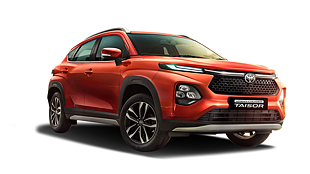What is it?
Why I would buy it?
Luxurious, spacious and comfortable cabin, Toyota reliability
Why I would avoid it?
Intended price-point, lacks snob value

We have finally experienced the big daddy of MPVs; the Toyota Vellfire. One look at this enormous MPV in flesh is all it takes to make the Innova Crysta look deficient. So, in terms of sheer size, the Vellfire is 200mm longer, 20mm wider and 100mm taller than its popular sibling.

As for the design, whichever way you look at it, there’s no mistaking the Vellfire for anything but an MPV; I mean how much boxier can it get? Nevertheless, when viewed from head-on, the extensively decorated nose reminded me of some robot off the ‘Transformers’ movie.

Obviously, not only is the design language quite sharp, the detailing too, along with quality and fit-and-finish is actually very good. In fact, we saw the Vellfire attract a lot of attention at our venue in Bangalore. Well, without further ado, let’s welcome the Toyota Vellfire.
How is it on the inside?

There’s a slight climb to get into the Vellfire. But once in, the first thing that catches your attention is the excellent visibility from the driver’s seat. This is thanks to it being perched so high up, with large glass panes to look out of, and a big quarter glass that’s shoe-horned into the A-pillar which negates blind-spots. Thankfully, the panorama camera view comes quite handy when negotiating tight confines or while backing-up.

As for the soft-touch dash, the design flows onto the door pads and the centre-console looks premium thanks in part to the chunky silver trim that runs around the large touchscreen infotainment system. Whether it is the physical controls for the player or the air-con controls, below it, everything is within reach on-the-go. This section then flows downwards onto a raked panel that holds the gear-shifter and other buttons to the various functions of this MPV.

Now, let’s talk about the seats. Interestingly, the first and second row benefit from both heating and cooling functions, plus memory settings. That apart, the front seats are quite comfortable thanks to ample back and shoulder support. What’s nice is that the passenger’s seat also benefits from the Ottoman feature, which is essentially a powered leg-rest.

So, is there enough space to keep your belongings at the front? Yes, inside the unique ‘both-sides’ opening large storage box between the seats, the spacious door pads, inside the two smaller cubbies around the gear shifter, and the glove-box. As you get past the powered sliding doors and onto the middle row, you can’t help but relish the enormous captain seats that offer great cushioning and support, along with the extravagant legroom.

This made it possible to liberate room needed for the adjustable leg-rests to pop-out from underneath; the electric adjustments for which are situated on the armrest. It just elevates the comfort quotient by a few notches. In fact, there’s a variety of electrical adjustments; some that also get the middle-row seats to drop-flat (business-class style)! What’s more, a compact retractable table folds out of the arm-rest, for say holding a tablet, and the cup holders are quite usable too. The door pads however are only good to hold a one-litre bottle.

Spending extended periods of time in these comfy seats shouldn’t pose a concern as the flattering real estate ambience is created by the big windows that can also be rolled down for some wind-in-the-hair experience. And in case you’d prefer some privacy, they have sun blinds too. As you slither behind the middle row to get to the third row, you're welcomed by the comfortable and adequately-sized seats (50:50 split) that can be reclined for a favourable seating posture.

What’s more, there’s adequate knee-room, and generous head and shoulder room (for two occupants). Come to think of it, although there’s space for three here (there’s a centre headrest), the gap where the two seats join can feel odd for the middle occupant. Passengers in the third row also get fold-down centre armrests, storage space under the window, sun-blinds, and their own AC vents. When it comes to the boot, loading luggage should be a breeze as the loading lip is quite low.

Likewise, boot space can expand from a minimum of 300-litres, which includes a covered section on the left where the spare wheel would ideally sit (spare wheel is placed on the right). And, as one slides the third-row seats back-and-forth or folds them upwards at either ends, the boot space swells accordingly. As for the JBL music system (17 speakers), sound quality is reasonably okay, and also plays off Apple CarPlay and Android Auto.

In terms of safety equipment, you get seven airbags, vehicle stability control, VDIM (vehicle dynamic integrated management), hill assist, auto-hold, tyre pressure monitoring and parking sensors along with a panorama view camera. Other highlights include rear ceiling screen (powered open/close, power tilt adjust, HDMI/WiFi connectivity), leather upholstery, 16-colour roof ambient illumination, three-zone climate control and heated steering. There’s also the powered side doors and boot lid, second and third row sun-blinds, twin sunroof and chauffeur controls (key-operated slide of side doors, one-touch seat upright etc).
How is it to drive?

Drive power for the 2815kg Vellfire comes from a petrol hybrid powertrain. It comprises of an internal combustion 2494cc engine which makes 115bhp/198Nm, and it works in conjunction with two electric motors. On the front axle is the one that makes 105kW (140bhp), and the rear electric motor makes 50kW (67bhp). The self-charging hybrid tech uses a nickel metal hydride battery. Toyota reiterated that this system essentially makes for an electronic '4WD' setup.

Apparently, there won’t be any off-road capabilities, and it’s more about powering the rear wheels when there's more demand, or if slip is detected. Additionally, an e-CVT gearbox does the transmission duties to feed drive to the front wheels. As you’d guess, there’s not much buzz when you hit the start/stop button as the IC engine is still dormant and the Vellfire actually gets on the move purely on electric power (if the battery is charged).

Now, based on how much throttle is fed, the needle on the left of the instrumentation hovers from the left to right. As it crosses the ‘Eco’ mark, the IC engine cranks and steps in to share its output to the wheels. This is when you can hear the motor whirring in the background. We have to admit that the whole driving experience right from the Vellfire getting into motion, it gaining speed where the IC engine kickedin, and the mild bursts of acceleration, are simply seamless. This matters most for the occupants as the drive will essentially be jerk-free.

Also, we noticed that there’s more than enough go for most driving situations, despite the bulk and the four occupants seated. Having said that, the typical CVT trait (read rubber-band effect) haunts you as soon as the throttle is floored. So the engine rpm stays high and can get quite vocal to deal with the additional demand for performance; more-so in the six-speed sequential mode. Till then, it’s just the road noise that filters into the otherwise peaceful cabin.

Interestingly, Toyota claims its Vellfire has been tuned to deliver 60 percent of the drive propulsion from the battery (40 percent engine), which is why the mileage claimed is a staggering 16.35kmpl! Let’s get to the handling now. Much to our surprise the steering on this monocoque MPV is light, smooth and increasingly progressive with three-and-half turns from lock-to-lock. These features coupled with a turning circle of around 5.1 metres, make it feel far from bulky on the move.

Braking too, is not only just confidence inspiring, there’s relatively good feedback at the pedal too. The electronics, discs on all four wheels and the 225-section tyres work in unison to bring about the desired results. However, we will have to reserve our judgement on the Vellfire’s ride quality for a later date as it sailed relentlessly on Toyota’s super-smooth tarmac test track at Bidadi.
Should I buy one?

With the Vellfire, Toyota aims to target affluent connoisseurs who value personal luxury space, indulgent comfort, status and exclusivity. All these, it certainly delivers in spades. Likewise, being a smart hybrid also saves fuel costs, and in-turn, the environment.
But all said and done, the true question will be the asking price. The Vellfire will be a CBU for now since local production cannot be justified for the predicted volumes of 600 units per annum. And that too, at approximately 80 lakhs (ex-showroom).

At this price-point though, the affluent-types tend to splurge on an exemplary brand, which allows them stand out from the crowd. Would they really be want to be seen in a Toyota? The way we see it, Toyota’s bullet-proof reliability, the Vellfire’s charm and its sure-shot pampering abilities may just about lure you into buying one.
Where does it fit in?

The Toyota Vellfire comes as an alternative to the Mercedes-Benz V-Class and the much cheaper Kia Carnival in the luxury MPV space.
Pictures by Kapil Angane

![Toyota Vellfire [2020-2023] Exterior Front Right Three-Quarter Toyota Vellfire [2020-2023] Exterior Front Right Three-Quarter](https://imgd.aeplcdn.com/642x361/n/cw/ec/45500/toyota-vellfire-exterior-front-right-three-quarter282.jpeg?wm=1&q=80)
![Toyota Vellfire [2020-2023] Right Front Three Quarter Toyota Vellfire [2020-2023] Right Front Three Quarter](https://imgd.aeplcdn.com/642x361/n/cw/ec/45500/toyota-vellfire-right-front-three-quarter226.jpeg?wm=1&q=80)
![Toyota Vellfire [2020-2023] Rear View Toyota Vellfire [2020-2023] Rear View](https://imgd.aeplcdn.com/642x361/n/cw/ec/45500/toyota-vellfire-rear-view229.jpeg?wm=1&q=80)
![Toyota Vellfire [2020-2023] Rear View Toyota Vellfire [2020-2023] Rear View](https://imgd.aeplcdn.com/642x361/n/cw/ec/45500/toyota-vellfire-rear-view231.jpeg?wm=1&q=80)
![Toyota Vellfire [2020-2023] Left Rear Three Quarter Toyota Vellfire [2020-2023] Left Rear Three Quarter](https://imgd.aeplcdn.com/642x361/n/cw/ec/45500/toyota-vellfire-left-rear-three-quarter228.jpeg?q=80)
![Toyota Vellfire [2020-2023] Left Rear Three Quarter Toyota Vellfire [2020-2023] Left Rear Three Quarter](https://imgd.aeplcdn.com/642x361/n/cw/ec/45500/toyota-vellfire-left-rear-three-quarter236.jpeg?wm=1&q=80)
![Toyota Vellfire [2020-2023] Left Front Three Quarter Toyota Vellfire [2020-2023] Left Front Three Quarter](https://imgd.aeplcdn.com/642x361/n/cw/ec/45500/toyota-vellfire-left-front-three-quarter238.jpeg?wm=1&q=80)
![Toyota Vellfire [2020-2023] Left Front Three Quarter Toyota Vellfire [2020-2023] Left Front Three Quarter](https://imgd.aeplcdn.com/642x361/n/cw/ec/45500/toyota-vellfire-left-front-three-quarter248.jpeg?wm=1&q=80)
![Toyota Vellfire [2020-2023] Image Toyota Vellfire [2020-2023] Image](https://imgd.aeplcdn.com/272x153/n/cw/ec/41217/toyota-vellfire-right-front-three-quarter5.jpeg?q=80)























